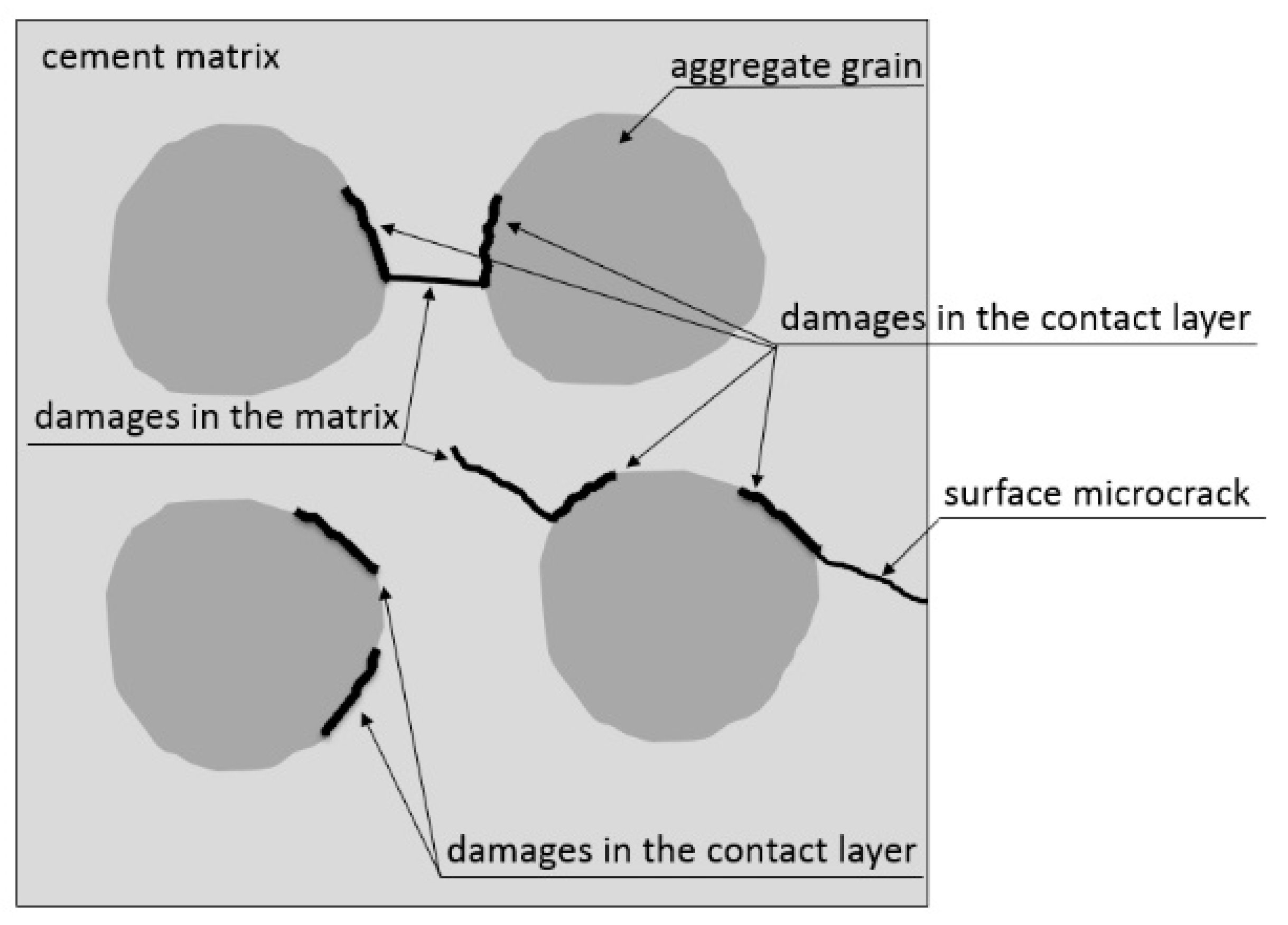Acoustic Emission for Determining Early Age Concrete Damage as an Important Indicator of Concrete Quality/Condition before Loading
Abstract
1. Introduction
2. Materials and Methods
3. Results
3.1. Test Results
3.1.1. Concrete W3—Curing in Water, Variable Hardening Temperature (+42 to −5 °C)
3.1.2. Reinforced Concrete W4—Curing in Water, Variable Hardening Temperature (+42 to −5 °C)
3.1.3. Concrete W6—Curing in Water, Constant Hardening Temperature of 22 °C
3.1.4. Concrete W7—Curing in Water, Constant Hardening Temperature of 22 °C
3.1.5. Concrete B2 (with Admixtures)—Curing in Water, Constant Hardening Temperature of 22 °C
3.1.6. Concrete B4—Curing in Water, Constant Hardening Temperature of 22 °C
3.2. Destructive Processes Analysis
4. Discussion
- In the case of hardening at varied temperature, class II damage (internal microcrack development) increases but class III (surface microcracks) decreases in reinforced concrete, which confirms that the reinforcement restricts most dangerous class III damage (Figure 14),
- All damage processes increase in the case of hardening at variable temperature (Figure 15).
Author Contributions
Funding
Acknowledgments
Conflicts of Interest
References
- Wu, Z.; Wong, H.S.; Buenfeld, N.R. Transport properties of concrete after drying-wetting regimes to elucidate the effects of moisture content hysteresis and microcracking. Cem. Concr. Res. 2017, 98, 136–154. [Google Scholar] [CrossRef]
- Kurdowski, W. Cement and Concrete Chemistry; Springer: London, UK, 2014; pp. 1–677. ISBN 978-94-007-7944-0. [Google Scholar]
- Neville, A.M. Properties of Concrete, 5th ed.; Prentice Hall: Lincoln, UK, 2011; pp. 1–872. ISBN 978-0-273-75580-7. [Google Scholar]
- Bischop, J.; van Mier, J.G.M. How to study drying shrinkage microcracking in cement-based materials using optical and scanning electron microscopy? Cem. Concr. Res. 2002, 279–287. [Google Scholar] [CrossRef]
- Boshoff, W.; Combrinck, R. Modelling the severity of plastic shrinkage cracking in concrete. Cem. Concr. Res. 2013, 48, 34–39. [Google Scholar] [CrossRef]
- Flaga, K. Impact of residual stress on stress destruction and strength parameters of concrete [Wpływ naprężeń własnych na destrukcję naprężeniową i parametry wytrzymałościowe betonu—in Polish]. Inżynieria Bud. 1995, 6, 315–322. [Google Scholar]
- Golewski, G.; Sadowski, T. Analysis of brittle defects in concrete composites [Analiza kruchych uszkodzeń w kompozytach betonowych in Polish]. Czas. Tech. (Bud.) 2007, 104, 55–62. [Google Scholar]
- Schindler, A.; Byard, B.; Tankasala, A. Mitigation of early-age cracking in concrete structures. MATEC Web Conf. 2019, 284, 07005. [Google Scholar] [CrossRef]
- Flaga, K.; Furtak, K. Problem of thermal and shrinkage cracking in tanks vertical walls and retaining walls near their contact with solid foundation slabs. Archit. Civil Eng. Environ. 2009, 2, 23–30. [Google Scholar]
- Linek, M.; Nita, P. Thermal Stress in Concrete Slab of the Airfield Pavement. J. KONBiN 2020, 50. [Google Scholar] [CrossRef]
- Kwak, H.G.; Ha, S.J. Plastic shrinkage cracking in concrete slabs. Part I Mag. Concr. Res. 2006, 58, 505–516. [Google Scholar] [CrossRef]
- Raczkiewicz, W.; Bacharz, K.; Bacharz, M.; Grzmil, W. Manufacturing Errors of Concrete Cover as a Reason of Reinforcement Corrosion in Precast Element—Case Study. Coatings 2019, 9, 702. [Google Scholar] [CrossRef]
- Klemczak, B.; Knoppik-Wróbel, A. Early age thermal and shrinkage cracks in concrete structures—description of the problem. Archit. Civil Eng. Environ. 2011, 2, 35–47. [Google Scholar]
- Ranachowski, Z. Application of acoustic emission to fault diagnosis in civil engineering. Roads Bridges 2012, 2, 65–87. [Google Scholar]
- Ohtsu, M.; Isoda, T.; Tomoda, Y. Acoustic Emission Techniques Standardized for Concrete Structures. J. Acoust. Emiss. 2007, 25, 21–32. [Google Scholar]
- Hoła, J.; Schabowicz, K. State-of-the-art. Non-destructive methods for diagnostics testing of building structures anticipated development trends. Arch. Civil Mech. Eng. 2010, 10, 5–18. [Google Scholar] [CrossRef]
- Ohno, K.; Ohtsu, M. Crack classification in concrete based on acoustic emission. Constr. Build. Mater. 2010, 24, 2339–2346. [Google Scholar] [CrossRef]
- Ohtsu, M.; Shigeishi, M.; Iwase, H.; Kyotanagit, W. Determination of crack location type and orientation in a concrete structures by acoustic emission. Mag. Concr. Res. 1991, 43, 127–134. [Google Scholar] [CrossRef]
- Goszczyńska, B.; Świt, G.; Trąmpczyński, W.; Krampikowska, A.; Tworzewska, J.; Tworzewski, P. Experimental Validation of Concrete Crack Identification and Location with Acoustic Emission Method. Arch. Civil Mech. Eng. 2012, 12, 23–28. [Google Scholar] [CrossRef]
- Nair, A.; Cai, C.S. Acoustic emission monitoring of bridges Review and case studies. Eng. Struct. 2010, 32, 1704–1714. [Google Scholar] [CrossRef]
- Goszczyńska, B.; Świt, G.; Trąmpczyński, W. Monitoring of active destructive processes as a diagnostic tool for the structure technical state evaluation. Bull. Polish Acad. Sci. Tech. Sci. 2013, 6, 97–109. [Google Scholar] [CrossRef]
- Goszczyńska, B.; Świt, G.; Trąmpczyński, W. Analysis of the microcracking process with the Acoustic Emission method with respect to the service life of reinforced concrete structures with the example of the RC beams. Bull. Polish Acad. Sci. Tech. Sci. 2015, 63, 55–63. [Google Scholar] [CrossRef]
- Goszczyńska, B. Analysis of the process of crack initiation and evolution in concrete with acoustic emission testing. Arch. Civil Mech. Eng. 2014, 14, 134–143. [Google Scholar] [CrossRef]
- Świt, G. Predicting Failure Processes for Bridge—Type Structures made of Prestressed Concrete Beams Using the Acoustic Emission Method [Analiza Procesów Destrukcyjnych w Obiektach Mostowych z Belek Strunobetonowych z Wykorzystaniem Zjawiska Emisji Akustycznej in Polish]; Kielce University of Technology: Kielce, Poland, 2011; pp. 1–179. [Google Scholar]
- Karcili, M.; Alver, N.; Ohtsu, M. Application od AE rate-process analysis to damaged concrete structures due to earthquake. Mater. Struct. 2016, 49, 2117–2178. [Google Scholar] [CrossRef]
- Wu, K.; Chen, B.; Yao, W. Study on the AE characteristics of fracture process of mortar concrete and steel-fiber-reinforced concrete beams. Cem. Concr. Res. 2000, 30, 1495–1500. [Google Scholar] [CrossRef]
- Lura, P.; Couch, J.; Jensen, O.M.; Weiss, J. Early-age Acoustic emission measurements in hydrating cement paste: Evidence for cavitation during solidification due to self-desiccation. Cem. Concr. Res. 2009, 39, 426–432. [Google Scholar] [CrossRef]
- Van, D.; Abeele, K.; Desadeleer, W.; De Schutter, G.; Wevers, M. Active and passive monitoring of the early hydration process in concrete using linear and non linear acoustics. Cem. Concr. Res. 2009, 39, 426–432. [Google Scholar]
- Watanabe, T.; Ohno, T.; Hashimoto, C. Detection of Thermal Cracks in Early-Age Concrete by AE. Concr. Res. Lett. 2011, 2, 290–294. [Google Scholar]
- Iliopoulos, S.N.; Khattabi, Y.E.; Angelis, D.G. Towards the establishment of a continuous nondestructive monitoring technique for fresh concrete. J. Nondestruct. Eval. 2016, 35, 37. [Google Scholar] [CrossRef]
- Bischop, J.; van Mier, J.G.M. Drying shrinkage microcracking in cement-based materials. Heron 2002, 47, 163–184. [Google Scholar]
- Chotard, T.J.; Smith, A.; Rotureau, D.; Fargot, D.; Gault, C. Acoustic emission characterization of calcium aluminate cement hydration at an early stage. J. Eur. Ceram. Soc. 2003, 23, 387–398. [Google Scholar] [CrossRef]
- Sargolzahi, M.; Kodjo, S.A.; Rivard, P.; Rhazi, J. Effectiveness of nondestructive testing for the evaluation of alkali–silica reaction in concrete. Constr. Build. Mater. 2010, 24, 1398–1403. [Google Scholar] [CrossRef]
- Świt, G.; Zapała-Sławeta, J. Application of acoustic emission to monitoring the course alkali-silica reaction. Bull. Polish Acad. Sci. Tech. Sci. 2020, 68, 169–178. [Google Scholar]
- Newman, K.; Newman, I.B. Failure theories and design criteria for plain concrete. In Proceedings of the Civil Engineering Materials Conference; Te’eni, M., Ed.; Wiley-Interscience: London, UK, 1969; Part 2; pp. 963–996. [Google Scholar]
- Hoła, J. Determination of initiating and critical stress levels in compressed plain and high-strength concrete by Acoustic Emission. Arch. Acoust. 2000, 25, 57–65. [Google Scholar]
- Carni, D.L.; Scuro, C.; Lamonaca, F.; Sante Olivito, R. Damage analysis of concrete structures by means of acoustic emissions technique. Compos. Part B 2017, 115, 79–86. [Google Scholar] [CrossRef]
- Sagar, R.V.; Prasad, B.K.R. Damage limit states of reinforced concrete beams subjected to incremental cyclic loading using ratio analysis of AE parameters. Constr. Build. Mater. 2012, 35, 139–148. [Google Scholar] [CrossRef]
- Carpinteri, A.; Lacidogna, G.; Corrado, M.; Di Battista, E. Cracking and crackling in concrete-like materials: A dynamic energy balance. Eng. Fract. Mech. 2016, 155, 130–144. [Google Scholar] [CrossRef]
- Kiernożycki, W. Massive Caoncrete Structures [Betonowe Konstrukcje Masywne in Polish]; Polski Cement: Cracow, Poland, 2003. [Google Scholar]
- Miller, R.K. Acoustic Emission Testing. In Nondestructive Testing Handbook, 3rd ed.; Moore, P.O., Hill, E.v.K., Eds.; American Society for Nondestructive Testing: Columbus, OH, USA, 2005; Volume 6, pp. 1–446. [Google Scholar]
- Bacharz, M. Application of the Acoustic Emission Method to the Evaluation of Destructive Processes in Unloaded Concrete [Wykorzystanie Metody Emisji Akustycznej do Badania Procesów Destrukcyjnych w Betonie Nieobciążonym in Polish]; Kielce University of Technology: Kielce, Poland, 2016. [Google Scholar]
- Bacharz, M.; Trąmpczyński, W.; Goszczyńska, B. Acoustic emission method as a tool for the assessment of influence of the temperature variation on destructive processes created in early age concrete. MATEC Web Conf. 2019, 284, 1–12. [Google Scholar] [CrossRef]
- Bacharz, M.; Goszczyńska, B.; Trąmpczyński, W. Analysis of destructive processes in non-loaded early-age concrete with acoustic emission method. Procedia Eng. 2015, 108, 245–253. [Google Scholar] [CrossRef]
- Bacharz, M.; Trąmpczyński, W. Identification of active destructive processes in unloaded early-age concrete with the use of Acoustic Emission method. In Proceedings of the 2016 Prognostics and System Health Management Conference (PHM-Chengdu), Chengdu, China, 19–21 October 2016; pp. 1–6. [Google Scholar]

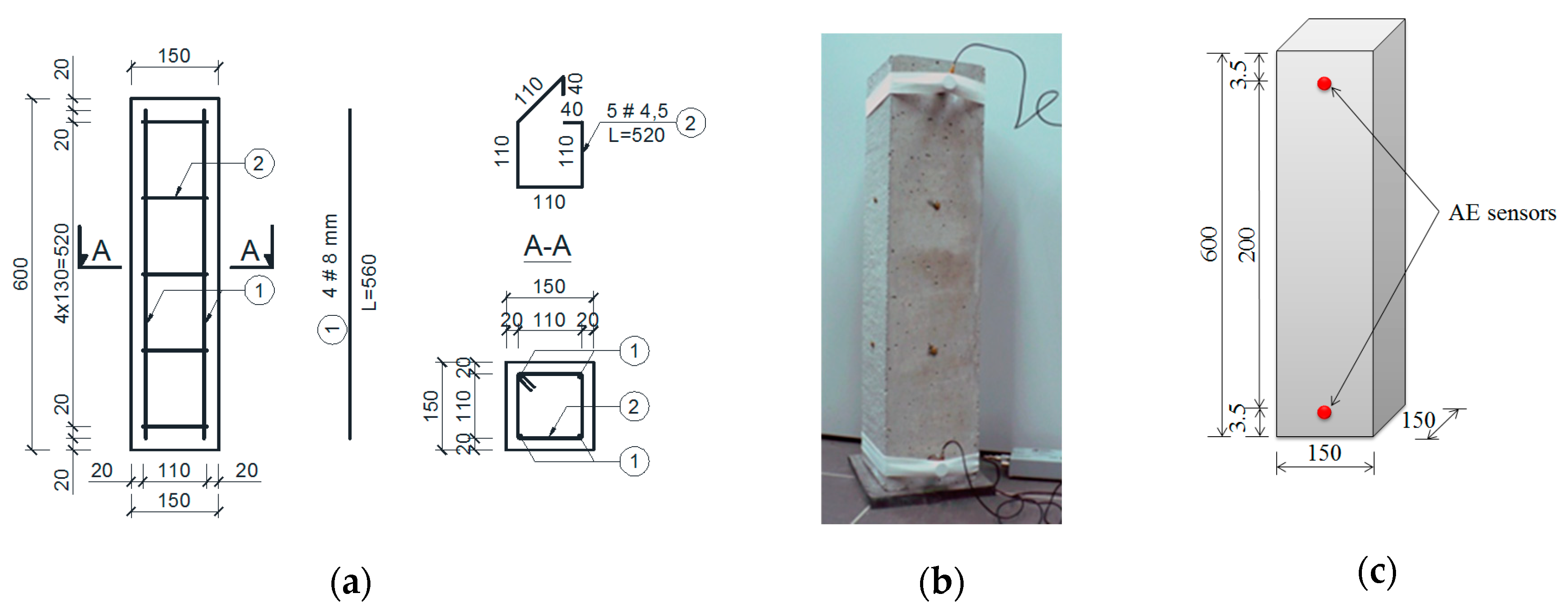
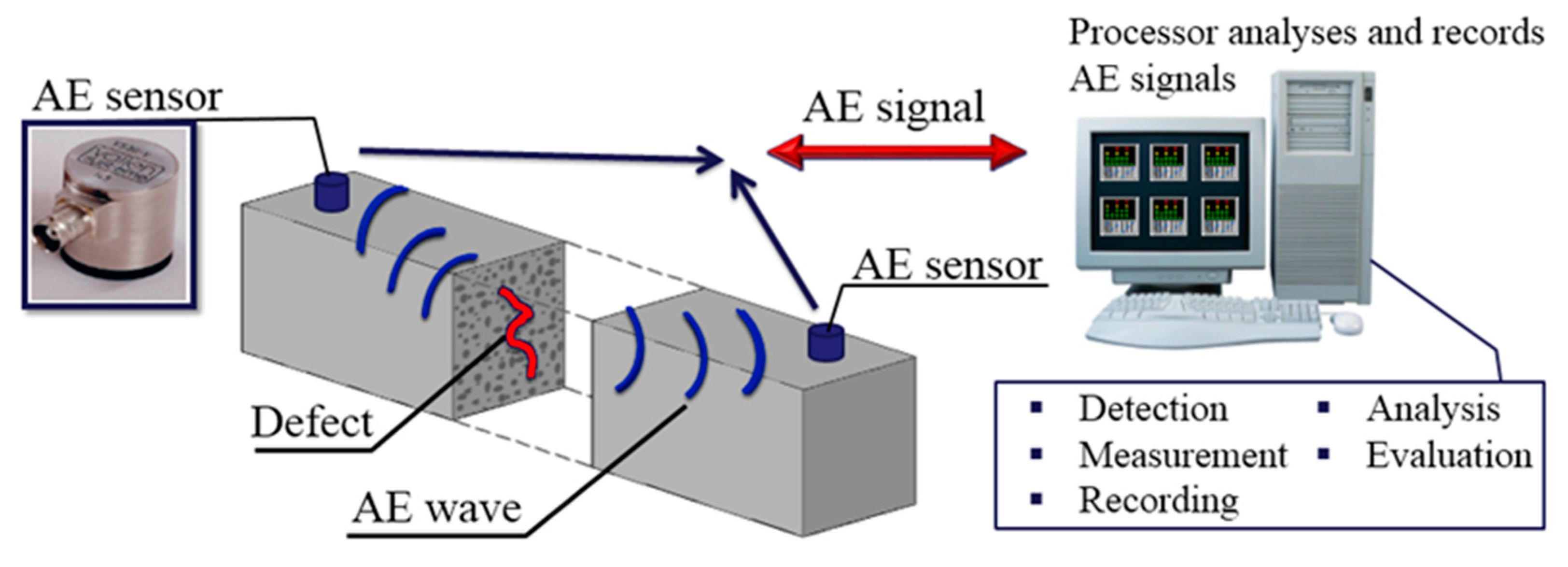


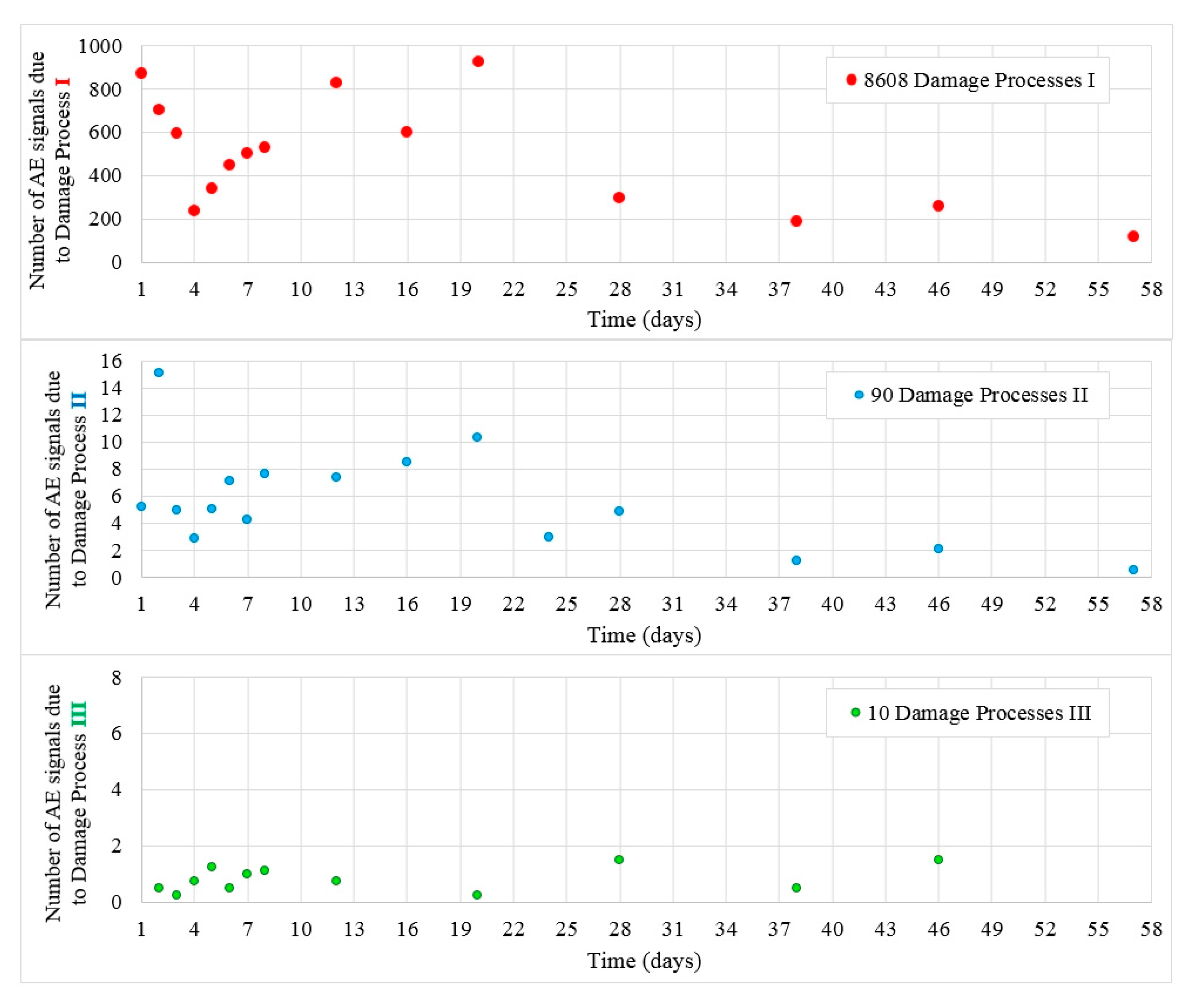


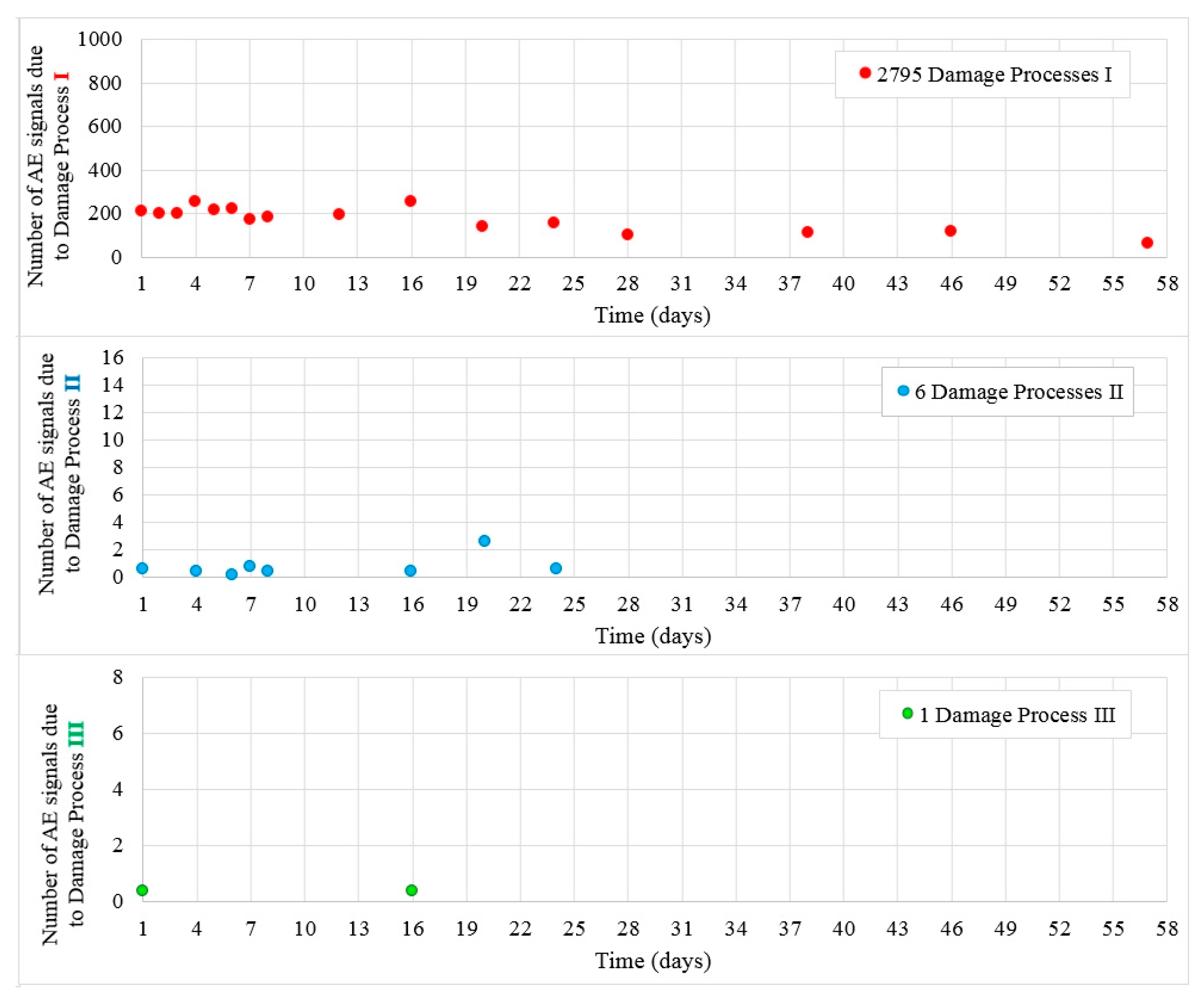

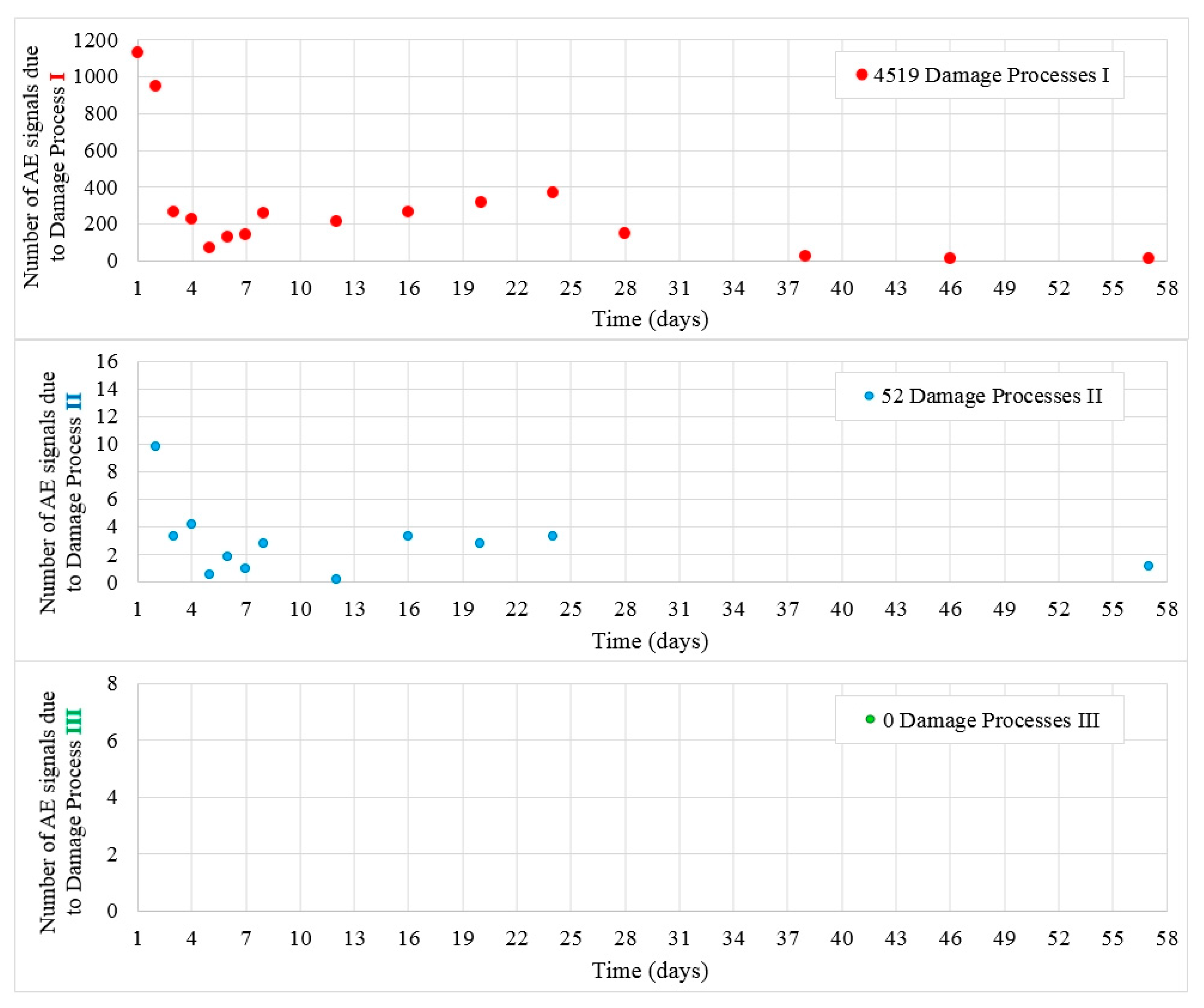
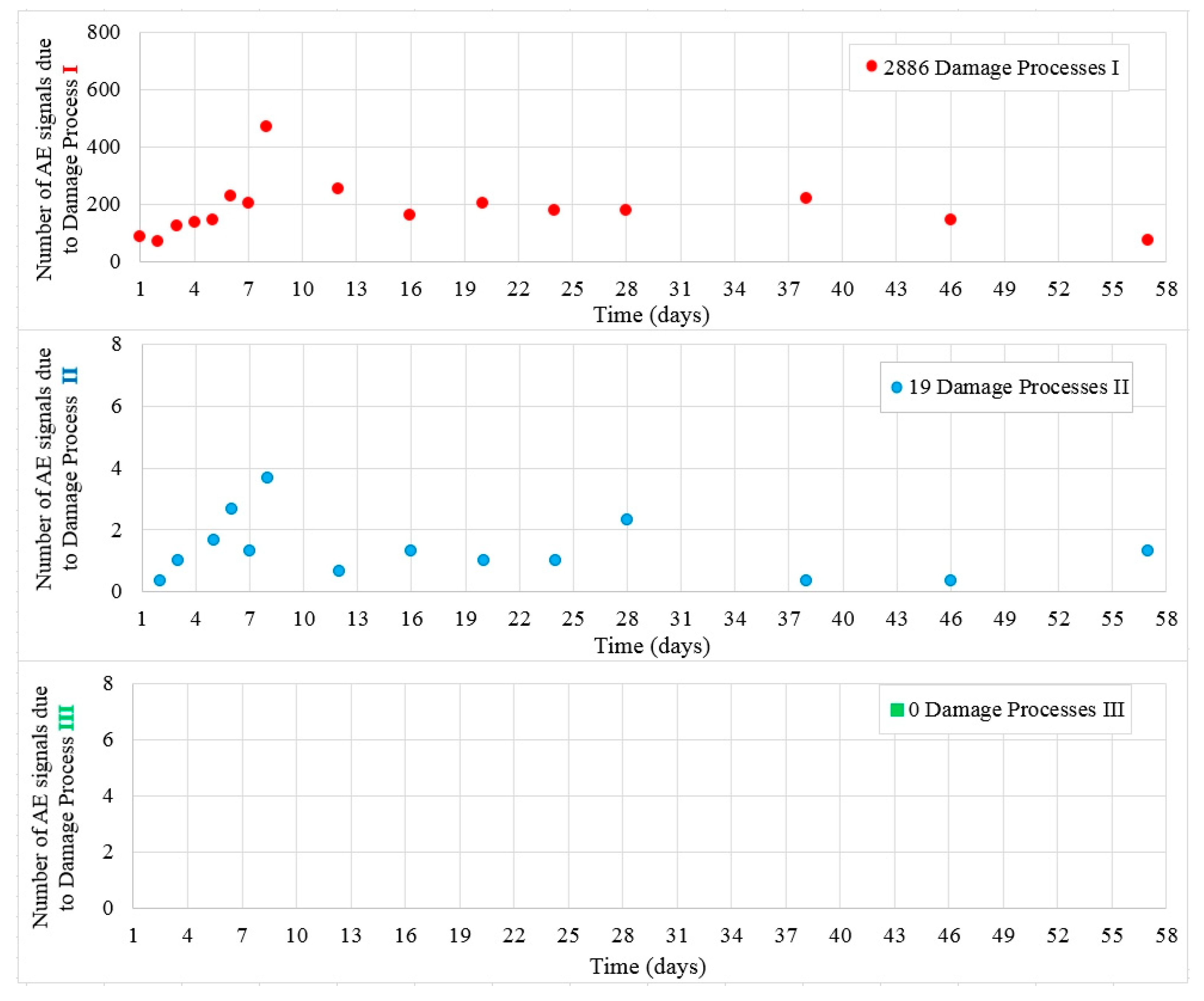
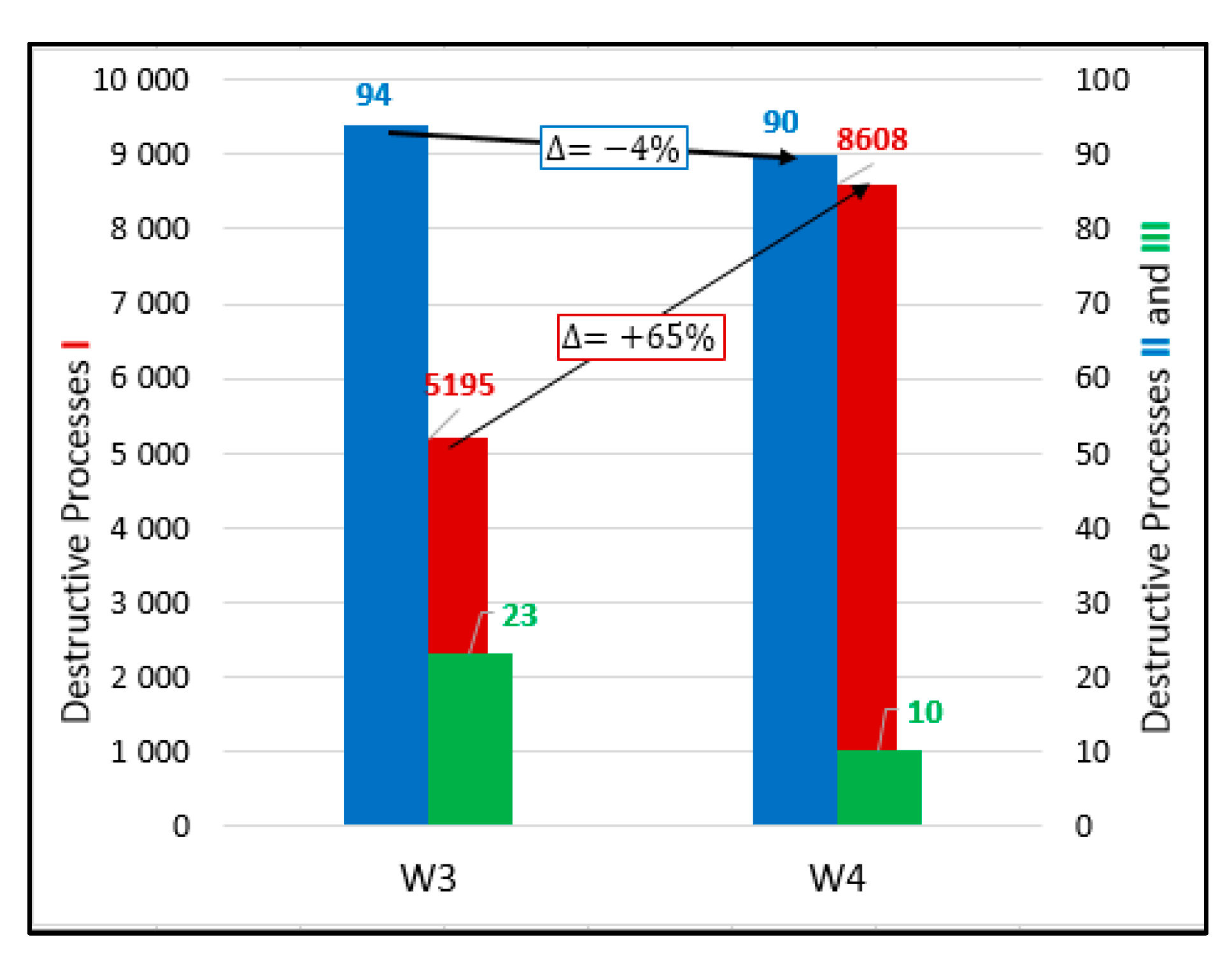
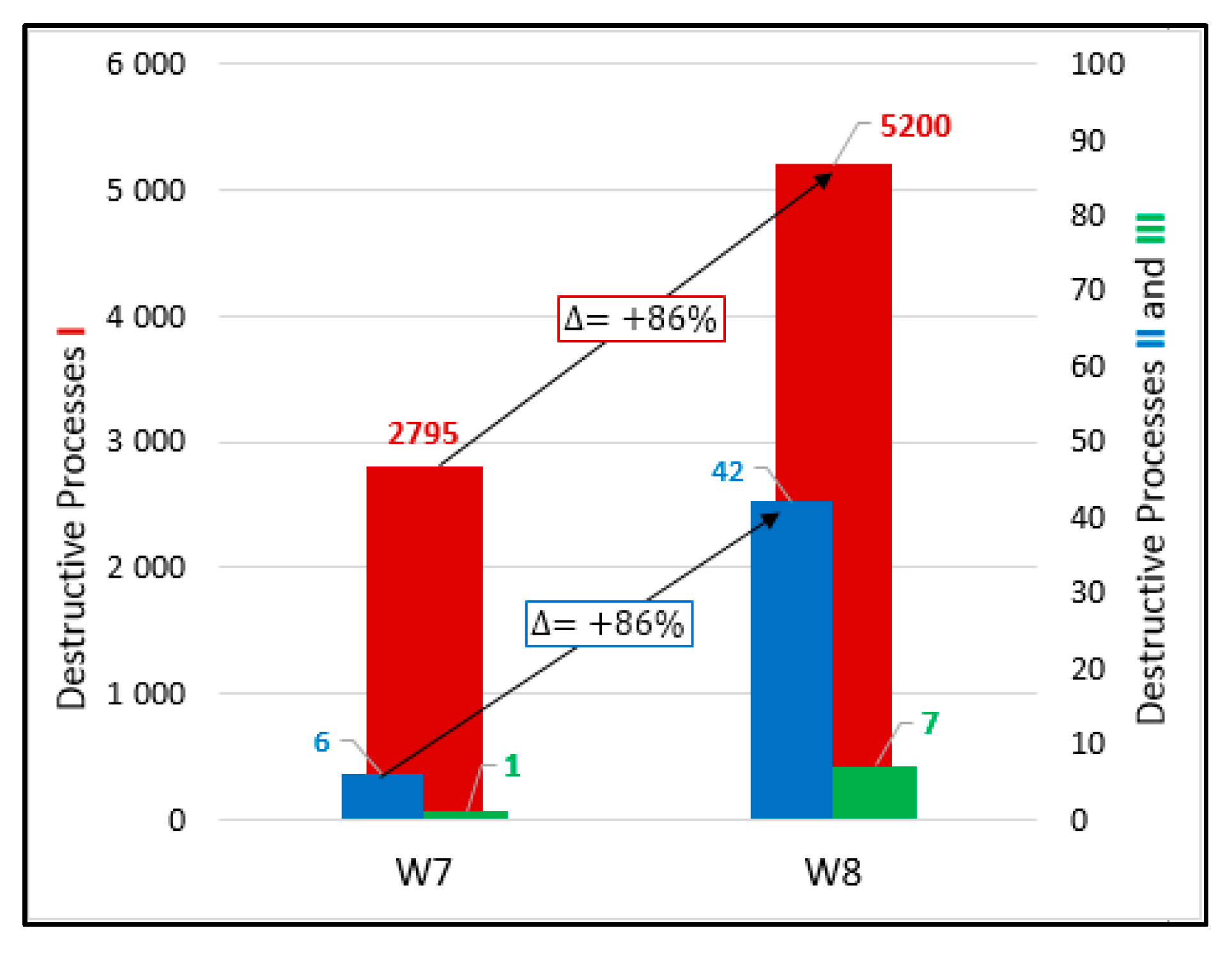
| Cement | CaO | MgO | SiO2 | Al2O3 | Fe2O3 | SO3 | Na2Oeq | Cl− |
|---|---|---|---|---|---|---|---|---|
| CEM I | 66.03 | 0.79 | 21.23 | 3.66 | 3.21 | 2.63 | 0.43 | 0.076 |
| CEM III | 2.69 | 0.81 | 0.066 |
| Symbol | Aggregate 2–16 | Sand 0–2 | CEMI/CEMIII | Water | Air Entraining Agent | Plasticizer |
|---|---|---|---|---|---|---|
| W3–W8 | 1110 1 | 740 | 338 (CEMI) | 169 | 0 | 0 |
| W2 | 1073 1 | 777 | 290 (CEMI) | 188 | 0 | 0 |
| B2 | 1312 2 | 691 | 360 (CEMI) | 150 | 0.36 | 1.98 |
| B3, B4 | 1312 2 | 691 | 360 (CEMIII) | 180 | 0 | 0 |
| Series | Water Curing (days) | Hardening Temperature | Cement Type | Concrete Class |
|---|---|---|---|---|
| W2 | 10 | constant 22 ± 2 °C | CEMI | C25/30 |
| W3 | 10 | varied −5 to + 42 °C | CEMI | C30/37 |
| W4 (reinforced) | 10 | varied −5 to + 42 °C | CEMI | C30/37 |
| W5 | 10 | constant 22 ± 2 °C | CEMI | C30/37 |
| W6 (100 × 100 × 500) | 10 | constant 22 ± 2 °C | CEMI | C30/37 |
| W7 (without curing) | none | constant 22 ± 2 °C | CEMI | C30/37 |
| W8 (without curing) | none | varied −5 to +42 °C | CEMI | C30/37 |
| B2 (with admixtures) | 10 | constant 22 ± 2° C | CEMI | C40/50 |
| B3 different agregate type) | 10 | constant 22 ± 2 °C | CEMI | C40/50 |
| B4 | 10 | constant 22 ± 2 °C | CEM III | C30/37 |
| Denotation | AE (Acoustic Emission) Signal Class | Number of Destructive Process | The Source of the Destructive Process |
|---|---|---|---|
| ● | Class 1 | I | formation of internal microcracks |
| ● | Class 2 | II | propagation of internal microcracks |
| ● | Class 3 | III | formation of surface microcracks |
| ● | Class 4 | IV | propagation of surface cracks |
| Series | Curing Conditions (Days of Curing) | Hardening Temperature | Cement Type | Concrete Strength after 28 Days (MPa) | Process | No of Signals |
|---|---|---|---|---|---|---|
| W2 | 10 | constant 22 ± 2 °C | CEMI | 36.0 | I | 5980 |
| II | 31 | |||||
| III | 0 | |||||
| W3 | 10 | variable −5 to +42 °C | CEMI | 44.5 | I | 5195 |
| II | 94 | |||||
| III | 23 | |||||
| W4 (reinforced) | 10 | variable −5 to +42 °C | CEMI | 44.5 | I | 8608 |
| II | 90 | |||||
| III | 10 | |||||
| W5 1 | 10 | constant 22 ± 2 °C | CEMI | 40.1 | I | 2192 |
| II | 9 | |||||
| III | 0 | |||||
| W6 (100 × 100 × 500) | 10 | constant 22 ± 2 °C | CEMI | 40.1 | I | 2560 |
| II | 6 | |||||
| III | 0 | |||||
| W7 (without curing) | none | constant 22 ± 2°C | CEMI | 45.8 | I | 2795 |
| II | 6 | |||||
| III | 1 | |||||
| W8 1 (without curing) | none | variable −5 to +42°C | CEMI | 41.2 | I | 5200 |
| II | 42 | |||||
| III | 7 | |||||
| B2 2 (with admixtures) | 10 | constant 22 ± 2 °C | CEMI | 63.5 | I | 4519 |
| II | 52 | |||||
| III | 0 | |||||
| B3 2 different agregate type) | 10 | constant 22 ± 2 °C | CEMI | 55.8 | I | 2984 |
| II | 18 | |||||
| III | 0 | |||||
| B4 | 10 | constant 22 ± 2 °C | CEM III | 48.1 | I | 2886 |
| II | 19 |
© 2020 by the authors. Licensee MDPI, Basel, Switzerland. This article is an open access article distributed under the terms and conditions of the Creative Commons Attribution (CC BY) license (http://creativecommons.org/licenses/by/4.0/).
Share and Cite
Trąmpczyński, W.; Goszczyńska, B.; Bacharz, M. Acoustic Emission for Determining Early Age Concrete Damage as an Important Indicator of Concrete Quality/Condition before Loading. Materials 2020, 13, 3523. https://doi.org/10.3390/ma13163523
Trąmpczyński W, Goszczyńska B, Bacharz M. Acoustic Emission for Determining Early Age Concrete Damage as an Important Indicator of Concrete Quality/Condition before Loading. Materials. 2020; 13(16):3523. https://doi.org/10.3390/ma13163523
Chicago/Turabian StyleTrąmpczyński, Wiesław, Barbara Goszczyńska, and Magdalena Bacharz. 2020. "Acoustic Emission for Determining Early Age Concrete Damage as an Important Indicator of Concrete Quality/Condition before Loading" Materials 13, no. 16: 3523. https://doi.org/10.3390/ma13163523
APA StyleTrąmpczyński, W., Goszczyńska, B., & Bacharz, M. (2020). Acoustic Emission for Determining Early Age Concrete Damage as an Important Indicator of Concrete Quality/Condition before Loading. Materials, 13(16), 3523. https://doi.org/10.3390/ma13163523




